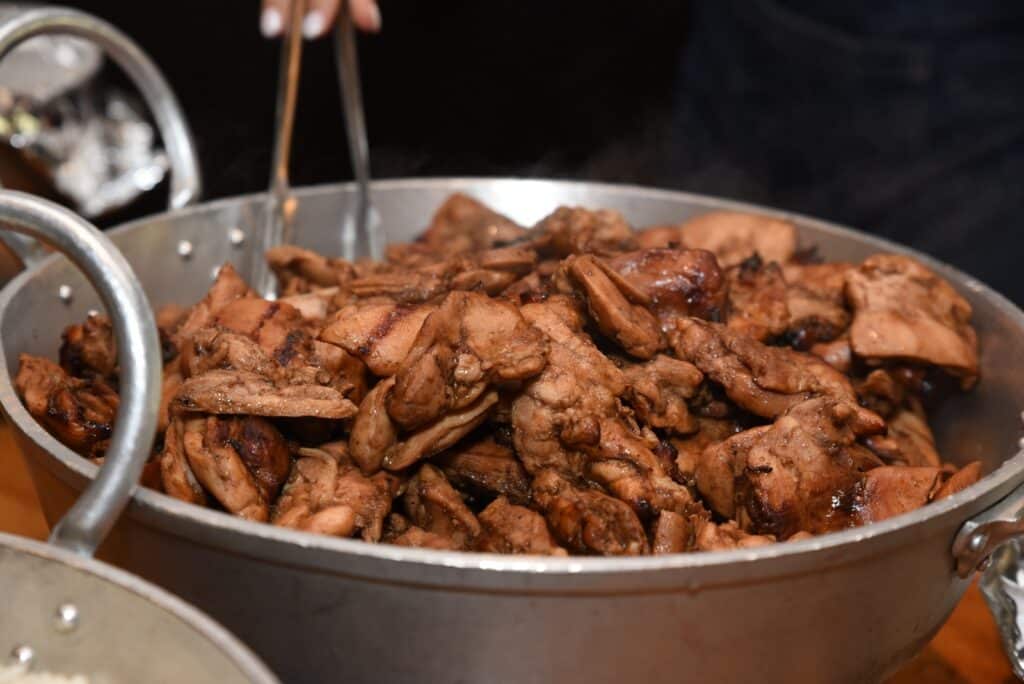In the realm of culinary delights, the Taramasalata recipe stands as a testament to the art of serving others. This delectable dish, originating from the Mediterranean region, offers a harmonious blend of flavors and textures that is sure to captivate the palates of those fortunate enough to partake in its splendor.
Gather your ingredients and embark on a culinary journey, as this recipe takes you through a series of steps that result in a creamy and velvety dip. Begin by soaking bread in water, allowing it to soften before draining and squeezing out any excess moisture. The bread is then combined with onion and garlic, creating a fragrant and savory foundation. Utilizing the power of a blender, these ingredients are transformed into a smooth and luscious mixture. Finally, a drizzle of olive oil and fresh herbs adorn this masterpiece, enhancing its visual appeal and adding a final touch of flavor.
Served alongside pita bread or fresh vegetables, Taramasalata is a versatile dish that can be enjoyed as a dip, a spread, or even as a unique accompaniment to seafood. With its delightful combination of ingredients and elegant presentation, this recipe exemplifies the art of culinary service, offering a taste experience that is both satisfying and memorable. So, gather your ingredients, sharpen your knife, and embark on a journey that celebrates the joy of serving others through the creation of this exquisite Taramasalata recipe.
Gather Your Ingredients
The initial step in preparing taramasalata involves assembling the necessary ingredients, akin to arranging the diverse pieces of a culinary jigsaw puzzle. To achieve a smooth and creamy texture, it is crucial to prepare the bread for soaking properly. One tip is to remove the crust and tear the bread into small pieces to ensure even absorption of flavors. Soak the bread in water, as described in the subsequent section, to continue the process.
Soak the Bread in Water
Immersing the bread in water is an essential step in the preparation of taramasalata, allowing it to absorb moisture and contribute to the desired creamy texture of the dish. Soaking bread in recipes offers several benefits, including softening the bread, enhancing its flavor, and binding the ingredients together. However, it is important to avoid common mistakes such as using too much water, which can make the bread mushy. Once the bread has soaked sufficiently, it is necessary to drain and squeeze the excess water from it before proceeding to the next stage.
Drain and Squeeze the Excess Water from the Bread
To achieve the desired texture and prevent the bread from becoming mushy, it is crucial to effectively drain and squeeze out any excess water before proceeding with the preparation. Soaking the bread in water helps soften it and allows it to blend smoothly with the other ingredients. This step is essential in creating a creamy and smooth taramasalata. Once the excess water is removed, the bread can be added to the blender along with the onion and garlic to continue with the recipe.
Add the Bread, Onion, and Garlic to the Blender
Next, combine the drained bread, onion, and garlic in the blender to continue the preparation process.
- The bread provides a creamy texture and helps bind the ingredients together.
- The onion adds a subtle sweetness and depth of flavor.
- The garlic adds a pungent and savory taste.
- Blending these ingredients together creates a smooth and well-incorporated mixture, ready to be seasoned and garnished.
Now that the bread, onion, and garlic are blended, the next step is to blend until smooth.
Blend Until Smooth
After combining the bread, onion, and garlic in the blender, continue blending until the mixture becomes smooth and well-incorporated. To engage the audience, here is a table that highlights different blending techniques and alternative ingredients that can be used to enhance the flavor and texture of the taramasalata:
| Blending Techniques | Alternative Ingredients |
|---|---|
| Pulse | Roasted red pepper |
| Puree | Avocado |
| Whip | Greek yogurt |
| Chop | Cucumber |
| Grind | Smoked salmon |
These techniques and ingredients can add a unique twist to the traditional taramasalata recipe. Moving forward, the next step is to gradually add the olive oil and lemon juice to the blended mixture.
Gradually Add the Olive Oil and Lemon Juice
In the following step, the blended mixture can be transformed into a harmonious blend of flavors by gradually incorporating the olive oil and lemon juice. This step requires careful blending techniques to ensure a smooth and creamy texture. The addition of olive oil adds richness and depth to the taramasalata, while the lemon juice provides a refreshing tang. Experimenting with different variations of taramasalata, such as using different oils or citrus fruits, can create unique and exciting flavors. Once the olive oil and lemon juice are well incorporated, the next step is to continue blending until the mixture is thoroughly combined.
Continue Blending Until Well Combined
To achieve a perfectly blended taramasalata with a smooth and creamy consistency, it is crucial to continue blending the mixture until all the ingredients are thoroughly combined. Blending techniques play a crucial role in achieving the desired texture. Whether using a blender or food processor, it is important to blend the mixture on a medium speed to prevent overmixing. Additionally, experimenting with flavor variations such as adding herbs or spices can enhance the overall taste. Once the blending process is complete, the next step is to add the tarama (fish roe) to the mixture.
Add the Tarama (Fish Roe) to the Mixture
To continue the blending process, it is important to add the Tarama, which is fish roe, to the mixture. This ingredient is essential in achieving the authentic flavor and texture of taramasalata. The addition of fish roe provides a rich and creamy consistency, while also infusing the dish with a subtle briny taste. Additionally, the use of fish roe allows for variations in the taramasalata recipe, as different types of roe can be used to create unique flavor profiles. To further enhance the smooth and creamy texture of the dip, the next step is to blend again until desired consistency is achieved.
Blend Again Until Smooth and Creamy
Continuing the culinary process, blend the mixture once more until it reaches a smooth and creamy consistency, enhancing the overall texture of the dip. Employ various blending techniques such as pulsing or using a high-speed blender to achieve the desired result. For those looking for alternative ingredients, consider using soaked cashews or silken tofu as a substitute for a creamier texture. This step prepares the dip for the next section, where we will season it with salt and pepper to taste.
Season with Salt and Pepper to Taste
In order to achieve a well-balanced flavor profile, it is essential to season the dip with salt and pepper to taste, adding a savory element to complement the creamy texture. While some may argue that excessive seasoning could overpower the delicate flavors of the other ingredients, a careful and measured approach will ensure that the dip is enhanced without becoming overly salty or peppery.
- Different ways to season taramasalata besides salt and pepper
- Pairing taramasalata with other Mediterranean dishes for a complete meal
Considering these discussion ideas, it is important to explore alternative seasoning options and explore how taramasalata can be paired with other Mediterranean dishes to create a satisfying and well-rounded meal.
Now that the dip has been seasoned to perfection, it is time to transfer it to a serving bowl.
Transfer to a Serving Bowl
After seasoning the Taramasalata with salt and pepper, it is time to transfer it to a serving bowl. Presentation is key when serving this delightful dish. Consider adding a vibrant garnish, like a drizzle of olive oil and fresh herbs, to enhance its visual appeal. Moreover, exploring variations of Taramasalata recipes from different cuisines can provide additional options to satisfy diverse palates. Let's now move onto the next step, garnishing with a drizzle of olive oil and fresh herbs.
Garnish with a Drizzle of Olive Oil and Fresh Herbs
To elevate the presentation of the Taramasalata, a final touch of elegance can be achieved by delicately drizzling a stream of olive oil and scattering a handful of fresh herbs on top. This simple act not only adds visual appeal but also enhances the flavors of the dish. Drizzling olive oil brings a richness and smoothness to the palate, although it can make the dish greasier. When it comes to garnishing with fresh herbs, options are abundant. Mint leaves provide a refreshing and aromatic note, while dill adds a subtle hint of anise. Parsley, on the other hand, offers a vibrant burst of color and a mild earthy flavor. By incorporating these herbs, the taramasalata is further elevated, creating a visually stunning and flavorful dish. To complete the serving, the taramasalata can be enjoyed with pita bread or fresh vegetables, allowing for a delightful combination of textures and tastes.
Serve with Pita Bread or Fresh Vegetables
Pita bread and fresh vegetables provide the perfect accompaniments to complement the exquisite flavors and textures of this delectable dish. Serve taramasalata with warm pita bread, sliced cucumbers, cherry tomatoes, and carrot sticks for an enticing spread that will surely impress your guests. To enhance the presentation, consider arranging the vegetables in a colorful and creative way, such as in a circular pattern around the taramasalata dip. Incorporating taramasalata into your diet not only adds a burst of flavor but also offers health benefits like being a good source of omega-3 fatty acids from the fish roe. Now, let's move on to the next section and enjoy!
Enjoy!
Indulging in the flavorsome taramasalata dip is a delightful way to savor the culmination of Mediterranean ingredients. This creamy and tangy dip can be enjoyed in various flavor variations, such as adding lemon zest for a citrusy twist or incorporating fresh dill for a herbaceous note. Serve the taramasalata with warm pita bread or a selection of fresh vegetables, providing a satisfying combination of textures. Optional: store any leftovers in an airtight container in the refrigerator for up to 3 days.
Optional: Store any leftovers in an airtight container in the refrigerator for up to 3 days
After enjoying the delectable taramasalata, it is wise to know how to store any leftovers for future indulgence. To maintain its freshness and flavor, it is recommended to transfer the remaining taramasalata into an airtight container and store it in the refrigerator. This will ensure its longevity for up to 3 days. In addition to the traditional use, the leftovers can also be creatively used as a dip, spread, or even incorporated into various recipes.
Frequently Asked Questions
How long does it take to make Taramasalata?
The preparation time for taramasalata varies depending on the recipe, but it typically takes about 20 minutes to make. For those who prefer alternatives to fish roe, options like avocado or cauliflower can be used as substitutes.
Can I substitute fish roe with something else?
Alternative ingredients for fish roe include mashed avocado, pureed tofu, or blended cooked beets. These options can provide a similar texture and flavor to fish roe, making them suitable substitutions for those looking for vegetarian or vegan alternatives.
Can I use a food processor instead of a blender?
Using a food processor for taramasalata offers several advantages. It provides a quick and efficient way to blend the ingredients, resulting in a smooth texture. However, a blender may provide better control over the consistency due to its higher speed settings.
Can I use dried herbs instead of fresh herbs for garnishing?
Using dried herbs for garnishing has its pros and cons. While dried herbs offer convenience and a longer shelf life, they lack the vibrant flavors and aromas of fresh herbs. However, they can still add a touch of herbal essence to dishes.
Can I freeze the Taramasalata for later use?
Freezing taramasalata is possible, although it may alter the texture slightly. It is important to note that some variations of taramasalata, such as those made with yogurt or cream, may not freeze well.
- 1. Gather Your Ingredients
- 2. Soak the Bread in Water
- 3. Drain and Squeeze the Excess Water from the Bread
- 4. Add the Bread, Onion, and Garlic to the Blender
- 5. Blend Until Smooth
- 6. Gradually Add the Olive Oil and Lemon Juice
- 7. Continue Blending Until Well Combined
- 8. Add the Tarama (Fish Roe) to the Mixture
- 9. Blend Again Until Smooth and Creamy
- 10. Season with Salt and Pepper to Taste
- 11. Transfer to a Serving Bowl
- 12. Garnish with a Drizzle of Olive Oil and Fresh Herbs
- 13. Serve with Pita Bread or Fresh Vegetables
- 14. Enjoy!
- 15. Optional: Store any leftovers in an airtight container in the refrigerator for up to 3 days
- 16. Frequently Asked Questions



